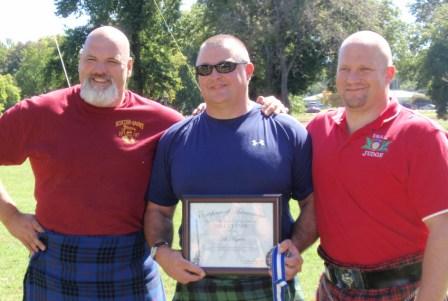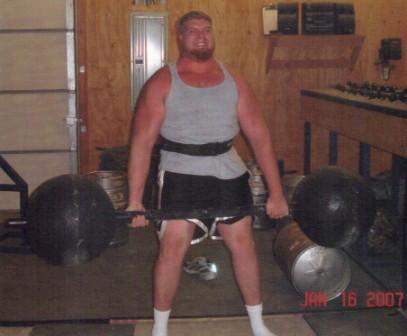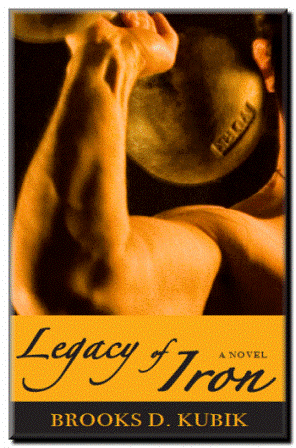Al Myers Inducted into the RMSA Hall of Fame
by Thom Van Vleck

Al Myers receiving the RMSA Hall of Fame Award Picture Left to Right: Thom Van Vleck, Al Myers, and Chad Ullom
I recently was contacted by Greg Bradshaw of the Rocky Mountain Scottish Athletes (RMSA) and asked if I would do the honors of inducting our own Al Myers into the RMSA Hall of Fame. They asked that I do it at the McPherson Scottish Highland Games in McPherson, Kansas. Al was the Athletic Director of this games for many years and built it into one of the premier Scottish Games in the Midwest. In 2007, Al hosted the Scottish Masters World Championships in McPherson. I presented a speech for Al and in it are things I think you should all know about him and that his involvement in Strength Sports goes far beyond the USAWA. Al has had quite a career as an athlete and going into the RMSA Hall of Fame (there has been only 6 inductees in over 30 years) is a just reward for a great athlete and friend.
The following is my speech:
We are here today to honor Al Myers and induct him in the RMSA Hall of Fame.
Al is a veterinarian and his family includes his Wife – Leslie of 23 years, and three daughters – Emily, Katie, and Molly. Al has always counted on their support.
As a competitor, Al started in the Highland Games in 1987 at the age of 20. He retired in 2005, after 19 years of competition. During that time he competed in over 200 Highland Games and over 100 Powerlifting Meets. Al competed as a professional Highland Games athlete for 10 years, from 1990 to 2000. He held the American Record in the 16# Sheaf toss in 1995, with a height of 35 feet (which is when I first met him). His best throws in the Highland Games were 16lb Sheaf 35 feet, 20# Sheaf 31 feet, Open Stone 48 feet, Bramaer Stone 38 feet, LWFD 81 feet, HWFD 41 feet, 16# Hammer 130 feet, 22# Hammer 108 feet, and WOB 15’11”. Al’s favorite and best event was the Caber Toss – an event he always placed high in. He has won over 100 Caber Competitions in his Highland Game career. Al was a 6 time Rocky Mountain athlete of the year – from the years 1991 to 1996 and held several RMSA records. As if this weren’t enough: Al also had a whole other athletic career in powerlifting. He was a 12 time state champion, 3 time collegiate National Champ and 7 time National Champion.
You would think the guy might want to take a break, but Al has continued on in another sport: The United States All-Round Weightlifting Association. He just recently was awarded Overall Best Lifter at this past year’s National Championships. He has won 6 All-Round National Championships since “Retiring” from the highland games, and was the Overall Best Lifter in three of these. He has won 3 All-Round World Championships, and was the Overall Best Lifter in the 2006 World Championships, which was held in Glasgow, Scotland. At the awards banquet following this competition he wore his Kilt to honor Scotland and the Scottish Games.
But Al was NOT just an Athlete. He was the Kansas representative to the Rocky Mountain Scottish Athletic organization for over 10 years. He was responsible for introducing many new throwers to the Highland Games and helped in getting new games started in other areas (including mine). Al has spent countless hours training new throwers at his gym, the DINO GYM, which is fully equipped as a Highland Games training complex! He has promoted several training Games at his place through the years to help build interest for the Highland Games athletics.
Today, even though he is retired as a thrower, Al is still very involved in coaching and promoting games. He just recently promoted the very first Highlander Nationals – which is a combination of Highland Game events and Strongman events.
But perhaps more importantly to those here today, he was the first athletic director of the McPherson Highland Games, and performed in that capacity until 2007. In his last year as athletic director of the McPherson Games, he hosted the Masters World Highland Games Championships.
Now, you might be thinking at this point that Al is Ten feet tall, weighs two tons, eats hammers and nails, and can take a shot gun blast standing…..his hammer actually travels faster than a speeding bullet, his run up on the Caber can derail a locomotive, and his WOB could clear the Empire State building……and those are his warm ups….
But joking aside, the reality is, Al is one of us and never made any of us feel any less. Scottish games are built on kith and kin, friends and family. Athletes used to participate knowing that the next day they might be called to fight side by side. Al very much embodied that friendship and made all of us that came after him feel like part of the highland games family. Al’s impact goes far beyond what I’ve talked about today. I cannot think of anyone more deserving of this recognition and it’s a standard that I know many of us here want to maintain. Thanks, Al, and may God continue to Bless you and your family for many years to come.

